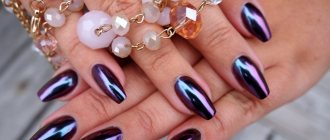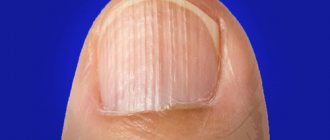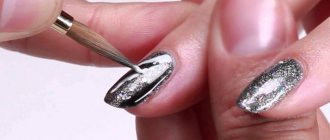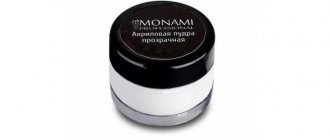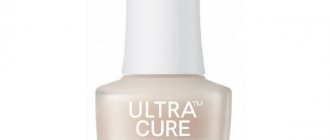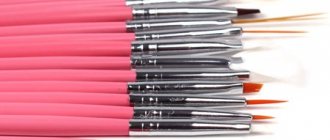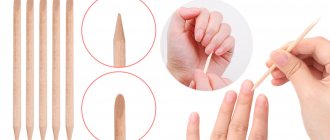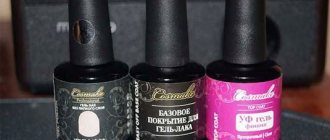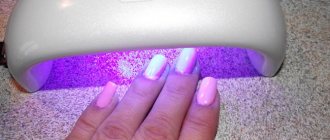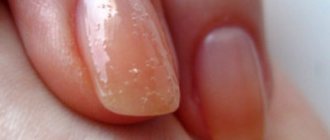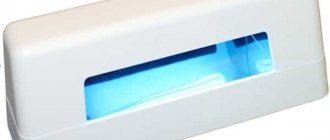Main types of funds
The base for nail polish should be chosen taking into account the characteristics and needs of the nails. A moisturizing base is suitable for dry nails that are prone to brittleness, as well as those that are too hard and thick. This product will make the nail plates more flexible, help them withstand some pressure and not break.
Strengthening base contains beneficial ingredients that make nails stronger. Ingredients may include gelatin, silicon, herbal extracts or proteins. Women say in their reviews that the base for the polish makes their nails strong and healthy. Bases that accelerate growth are also sold. Such funds can be used either independently or as a basis.
The “sticky” base improves the adhesion of the surface of the nail plate and the decorative coating. Some of these products are designed for use with gel polishes. The leveling base fills small irregularities on the surface of the nail, as a result of which further coating is applied and distributed evenly.
The final choice depends on the condition of the nails. If they are in order and nothing bothers you, then you can choose a universal foundation, strengthening or moisturizing.
Types of databases
Coating bases differ in their composition and functions. There are colorless, nude, light pink and colored single-phase foundations. Most of them contain silica gel and polymer - these materials are natural and harmless to health.
Rubber
The most common type of base, which is used to strengthen the nail before applying gel polish or extensions. The rubber included in its composition contributes to a dense and dense structure, which greatly simplifies the process of leveling the nail plate and applying the base layer.
Silicone
This base for varnish not only fits easily onto the nail, compacting its structure, but also allows you to remove the coating in the most gentle way possible. The silicone base usually comes in the form of a nail-shaped sticker that is attached to the plate.
Acrylic
Acrylic base is a synthetic composition, which includes a classic base and acrylic powder. It is usually used for nail extensions and correction. There is a transparent, white or colored base used to give the nail plate strength.
Gel-based (camouflage)
This product often combines top, base and colored gel polish at once. Camouflage coatings are gel-based, which means they have the structure of this material, which makes them easy to apply. At the same time, however, gel-based bases are a single-phase product that stays on the nail much less than the standard combination of top, base and gel polish.
With vitamins
The healing base for gel polish is suitable for brittle and damaged nails and is often used after acrylic extensions. Such formulations are enriched with vitamins E and D to stimulate the natural process of cell restoration and healing of the nail plate.
Water based
This type of base cannot be used for applying gel polishes; it is usually used for regular pigmented polishes. The water-based base does not contain a large number of chemicals; it is suitable for allergy sufferers, pregnant women and children.
Important! Drying of this manicure occurs naturally.
Anny: six in one
This product does not contain harmful elements in its composition. The brush for applying the foundation is very comfortable, moderately elastic, smooth, and distributes the base evenly. It dries for quite a long time, but makes the nail glossy, so it can be used as an independent product. The base must be applied in very thin layers and dried well, otherwise bubbles may appear.
Why do you need a nail base, what is it?
Nail base is a product that is applied first to a plate treated with a file and a buffer when performing a manicure with gel polish, followed by drying in a special lamp. Sometimes a primer must be applied before using it. The product looks like a transparent thick liquid, the texture varies depending on the purpose, type of nails and many other factors.
The base for gel polish is sold and stored in a bottle with a screw cap, to which an application brush is attached.
Nail base is a product that can not only make the coating more “long-lasting”, but also protect the plate from negative influences. In order not to confuse it with other liquids used in professional manicure, on the packaging you should look for the designations basec oat (regular substrate) or rubberbase (rubber), UV/LED Base, liquid polygel, UV gel polish, pale base, etc.
Applying the base
The base coat for nails is selected according to their type; it should also not conflict with the polymerizing varnish. Apply with a brush to the prepared plate, then dry in a lamp.
Compound
The exact composition depends on the type of product, but each contains keratins, polymers, vitamins, and a small percentage of water. Additional components are available in the following databases:
- rubber contains rubber, which provides it with elasticity, thickness, and the absence of involuntary flow onto the skin when applied;
- gel contains more polymers of different types, making the product durable after drying, glossy, and universal;
- acrylic contains acrylic, which provides nail plates with hardness and strong adhesion of the base and gel polish to the surface;
- silicone is characterized by the presence of silicones, which provide softness, elasticity, reliability, a gentle effect on nails, and easy removal.
Composition of the base for gel polish
What is it for?
A base is needed for professional manicure to ensure:
- strong adhesion of gel polish and nail plates, that is, necessary for long-term wear of the design without chipping or peeling;
- nail care, protection from penetration of the coloring components of the varnish;
- strengthening the plates if they are prone to brittleness or are too flexible or soft;
- straightening nails, hiding defects in the form of pits and bumps, cuts, microcracks, which also ensures long-term wearing of manicure;
- painting over external imperfections of the plates, for example, stains and uneven color or overgrown free edges;
- strong connection between the artificial material and the nail itself when performing extensions.
In addition, applying gel polish to the base makes the color brighter and more durable throughout the entire period of wearing the manicure.
Top or base first
It’s easy to guess from the names whether the top or base is applied first during a manicure - this is, of course, the second product. The base has more pronounced adhesive properties and less harmful effects on the nails. The final coating does not provide the necessary care, strengthening, or leveling.
And with shellac, first the base is applied to the treated plate, then the top comes. This type of decorative product also needs to strengthen the adhesion to the nails, despite its lightweight composition compared to gel.
Misunderstanding whether the first layer should be top or base arises from the external similarity of the products: both are transparent and have a thick consistency. But after application, the difference becomes obvious - the base looks less glossy. In addition, it can be laid in a thicker layer than the top coat.
Is it possible to use a base instead of a top?
You can use a base instead of a top, but you need to be prepared for the fact that such a manicure will deteriorate faster. The base will not provide the protection of gel polish from external influences that the top coat provides, because it is intended for something else. In addition, the glossy top shines brighter, and this property remains throughout the entire wearing of the design. And the matte top coat will provide the necessary dull texture longer. The top will protect the color of the varnish from fading, which cannot be said about the base.
True, recently “two-in-one” products have appeared, that is, combining a base and a top coat. They can be used simultaneously as a gel base and finish.
Dior Firming Foundation
This milky-peach base for varnish has a liquid consistency, due to which it is easily distributed over the nail plate and leveled independently. The result is a thin coating with good gloss and a pleasant natural shade. The base evens out the nail plate well. It dries quite quickly on the nails - about three minutes. When using a nail polish base with a strengthening effect, nails begin to grow faster and stop breaking. The colored varnish applies very well to the base and lasts a long time. This varnish base has earned only positive reviews.
Varnish base: is it necessary or not? Why did I give up the bases?
Leveling, strengthening, whitening, increasing durability, removing delamination - this is only a small fraction of what I remembered right away.
Of course, we are talking about bases for varnish.
About a year and a half ago, on my own blog, I published a post consisting of two parts, where I talked about all the databases I have, and after that I also got new ones. Now almost all of them are lying around idle, some have been thrown away long ago, I use only a few and in exceptional cases.
Because experience has shown: bases are an extra layer of varnish in a manicure and nothing more.
I would like to point out that this experience is only my own, I am not saying that this will be better for everyone, but I will explain my point of view.
The first reason is saving time. Yes, high-quality bases are usually applied as simply as possible (it was not enough for bases to be difficult to apply) and dry immediately. It would seem that it takes no more than ten minutes. But, you know, modern realities are such that even ten extra minutes will not be superfluous.
The second reason is that varnishes apply better to bare nails than to any of the bases. Than even to the aquabase, which is famous for taming the most harmful specimens.
This works with bald jellies, which on a bare nail suddenly cease to be bald and do not bubble, and with harmful creams (in particular, pastel shades), with which it is suddenly possible to make a thin first layer, which means avoiding those same sagging and - again or bubbles. I won’t even say anything about linear holographics.
The third reason follows from the second, and I have already mentioned it. Having given up bases, I almost forgot what bubble polishes were. Unless it's a completely nasty specimen that can only be helped by scrap. Or at least a high-quality top coat that dissolves bubbles.
The fourth reason is an even semicircle at the cuticle. Of course, a well-trained hand plays the main role here, followed by a quality brush. But it’s no secret that the second layer will follow the outlines of the first. When your first layer is a clear base, it may not be applied all that evenly, not all that close to the cuticle. When you paint a colored varnish right away, you can see what you're painting and can do everything a little more accurately.
The fifth reason is the durability of varnishes. No matter what they say about bases that increase durability, varnishes began to last as long as possible when I gave up bases altogether. I used to think that my nails had gotten really bad since they didn’t keep the polish on for more than two days. Nowadays I sometimes go four at a time and remove the polish in such a state as if I had just applied makeup yesterday.
The sixth reason is the condition of the nails. It would seem that everything should be the other way around. You use a base coat that protects your nails from colored varnish, and maybe even treats them (according to the manufacturer) - you have good, strong nails. If you don't use it, you don't have it. I haven't changed my nail care in any way over the last year; all my procedures are standard. But my nails, pah-pah-pah, began to look and behave much better. Once again pah-pah-pah.
In addition to the advantages listed above, eliminating the base coat also saved me money. I used to really love buying different bases, trying something new, testing the manufacturer’s honesty, checking his promises. At the same time, despite the range in prices (from one hundred to six hundred rubles per bottle), I received approximately the same thing everywhere. Of course, if I wanted, I could highlight the differences, pros and cons of each product... but was it worth it?
Perhaps the main (and probably the only real) danger when abandoning the varnish base is corrosive pigments of blue, red, orange, teal and similar shades. There is always a chance that one of them will leave behind a colored mark on your nails. At first, I didn’t take risks and still applied bases under “dangerous” colors. Then I got lazy. And in all these months, I've had to paint my nails about...zero times.
And, of course, your nails may turn yellow. This raises the question of how important this is to you. To be honest, I don’t care - I don’t go without nail polish. And even if I do, it makes absolutely no difference to me whether my nails are pink or yellowish. They have a neat shape, there are no cuticles or hangnails, the skin around the nails is moisturized, and the nails themselves are shiny. And even with a slight yellowness, they look many times better than what I often see on other people’s hands.
In fact, the only bases that I still use are glitter ones. And I even use them every once in a while, mostly colored ones, because it saves time: one layer of colored peel-off base is easier to apply than two or three layers of varnish. Even less often I resort to the help of Eveline “whitening” Instant effect of white and healthy nails, because such a whitish base goes well under some varnishes.
I get along just fine without base coats, which means I don’t plan on going back to using them. I feel comfortable, my nails feel comfortable, why ruin this idyll?
I would be glad to read your opinions on this matter
Nail surface corrector
Based on the results of application, the OPI corrector fully complies with the properties declared by the manufacturer. The product is translucent, slightly milky in color. The corrector mattifies, but it is not recommended to use it without colored varnish, because while filling all the unevenness efficiently, the product only emphasizes them. But when applying a layer of colored coating on top, the nails look perfect.
Base and top coat
Orly nail care product is universal. This is both a base for varnish and a topcoat. Decorative varnish fits well on it, and the nails themselves are not painted. The polish dries faster and lasts longer, and the nails themselves become glossy. This remedy is praised by many women. Those who have already tried coverage from Orly once do not want to go back to cheaper (although the base is quite budget-friendly, especially considering that this is a two-in-one product) bases.
Strengthening
This category of products is suitable for owners of weak and soft nails who want to strengthen them and protect them from staining.
Jessica DIAMONDS Endurance Diamond Powder Base
This base contains small diamond particles that strengthen your nails, give them strength and protect them from damage.
Yes, I want it!
Strengthening base and care for nails Essie “Millionails”
This coating has already gained popularity among girls due to its strengthening properties and quick drying. It is very easy to grow strong nails using this base coat.
Yes, I want it!
Morgan Taylor “Stick With It” Super Durable Base Coat
This basic product will give incredible strength, strength and flexibility to your nails, as well as excellent adhesion to decorative varnish.
Yes, I want it!
Nail polish Horsepower “3 in 1 Forte”, with a complex of fruit acids and biotin
This is a very popular product and a bestseller among varnish coatings. It combines three functions at once: base, coating and strengthener, that is, you can use it not only as a base, but also as a top and as an independent transparent coating. Horsepower restores nail strength and prevents delamination of the nail plate.
Yes, I want it!
Under gel polish
The base for the base of gel polish is not a product that is suitable for use with a regular decorative coating. The corrector base has received good reviews, as it provides strong adhesion and evens out the nail plate. This is Komilfo Gel Base Coat.
The product can be applied in a thin layer over the entire surface or spot-on to correct imperfections. Using this base, you can extend broken corners or the nail itself up to 1 mm. The product is sawed off (like gel polish), so that your nails can be given the desired shape. Nail base for gel polish is sold in five-milliliter bottles without a brush (it is convenient to apply the one used for acrylic).
How to choose the ideal base for gel polish
The base not only protects the nail plate, but also provides adhesion to the gel polish. The quality of the base determines how the manicure will look and how long it will last.
When choosing, you need to pay attention to:
- consistency
— liquid will reduce the working time, and thick will allow you to better model the nail plate; the second option is preferable for inexperienced artists;
- type
- can be self-leveling, which is convenient for manicure beginners, or strengthening with the possibility of extension; it also depends on the type how easy it will be to remove the coating;
- compound
— for example, hydrolyzed keratin increases the service life of the manicure base, and rubber gives the necessary elasticity;
- manufacturer
— it is desirable that the base and top should be from the same company to improve the quality of work.
Also, when choosing, you should take into account reviews about the base in order to know the features of working with it. Cost affects the availability of material and its payback. Even though they are economical, expensive foundations are still more profitable than regular visits to a specialist.
